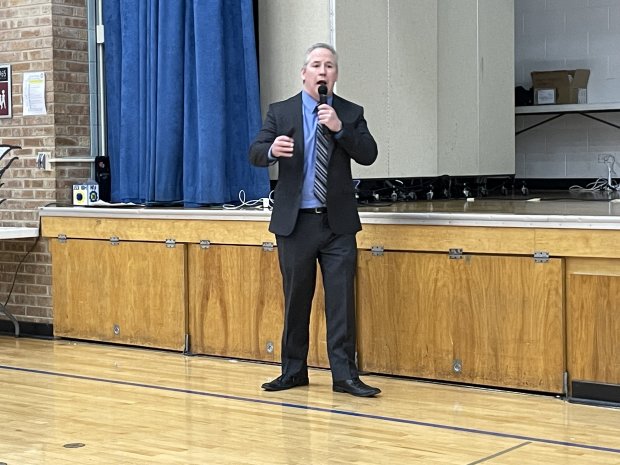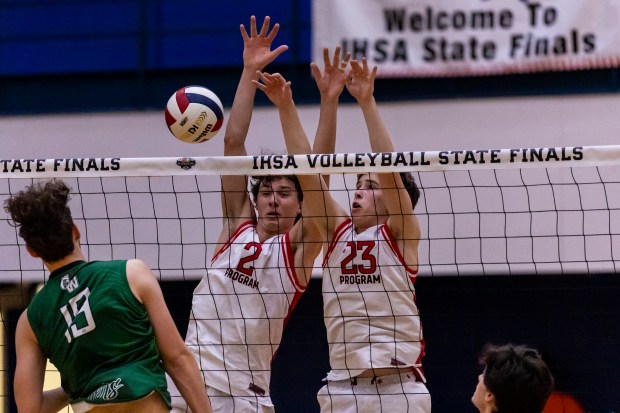Union Ridge School District in Harwood Heights is asking voters to approve a referendum question when they go to the polls March 19.
The $35 million bond issue requested by the district, which has one K-8 school, will cost the average property owner about $810 a year, according to a report presented during a district referendum meeting on Feb. 13.
The owner of a home worth $306,500 would pay an additional $810 annually for 25 years, if voters approve a request to overhaul and expand the district’s only school, which officials said is so overcrowded that former bathrooms and closets are used for offices and half of the library has been converted to classrooms.
“There are a limited number of things we can do because we are simply running out of space,” Superintendent Michael Maguire said. “We’ve got plenty of space outside in the back of the school where we can add the building space we need.”
Union Ridge, which opened in 1876 and was rebuilt in 1933 after a fire, has not been expanded since 1970, Maguire said. The last bond issue approved by voters came in 1967 for $595,000, he said.
The one-school district, which enrolls 640 to 680 students annually in pre-kindergarten through eighth grade, receives 76% of its annual funding through local property taxes, 16% from the state of Illinois and 8% from the federal government, Maguire said.
About 50 community members attended Tuesday’s referendum meeting, the first of three intended to present the case for the referendum and answer questions from the public.
The other two are scheduled for 7 p.m. on March 6 and 7 p.m. on March 14, both at the school.
The bond issue would allow Union Ridge to add eight classrooms and two science labs and reconfigure and relocate the library and cafeteria, Maguire said. It would improve ADA accessibility, create a more secure entrance, and repair and replace the building exterior and mechanical, electrical and plumbing systems, he said.
Jeff Huck, design director for Arcon, architects for the project, said a video presented Tuesday that outlines the problems with space in the school is “very polite” and that issues are much more serious than the video suggests.
“The spaces kids are going to each day are quite challenging,” Huck said. Union Ridge has undergone no significant change or addition to the building since 1970, he said.
“Between 1970 and the 2000s, education has changed dramatically,” Huck said. “A lot of the things we do today were not talked about from the 1920s to the 1970s.”
Among the changes are the adaptation of the middle school, the achievements required under the No Child Left Behind Act, the advent of the use of shared computers, the widespread distribution of individual digital devices, and the introduction of Individualized Education Programs, he said.

“Does the building still support what learning looks like in the classroom?” Huck said. “Does it support what we want for our children?”
District 86 created a list of nine different options for improving the school, ranging in cost from $300,000 a year to up to $120 million a year, he said. The one the Board of Education selected is the “most viable,” Huck said.
“It has the biggest bang for the dollars,” he said. “It checks the most boxes it can.”
At least three residents who attended Tuesday’s meeting said they agree that the school is badly in need of expansion and improvements, but said they have not yet decided on whether they will vote in favor of the bond issue.
“I’m in support of a better future for my kids,” said Pam Stratigakis of Harwood Heights. “I want to stay here, but I do not want to state my position until I have all the details.”
“I have to look at the tax thing,” said Bill O’Connor, a 41-year resident of Harwood Heights whose children and grandchildren have attended Union Ridge. “It’s too early to tell.”
Harwood Heights Trustee Larry Steiner, a 40-year resident who attended the meeting, said previous district administrations should have done something much sooner about the space problems.
“It’s a tough nut,” Steiner said. “Last year my taxes went up $800 for no reason. We’re looking at another $1,000 a year, but we need it. A lot needs to be done here, but I wish there was a better way to do it. It’s a tough situation.”





